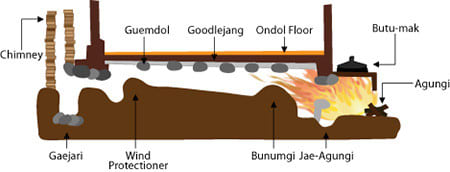

この河回村ハフェマウルという集落に来て不思議なのは
日本のように神社とか仏閣が見当たらないこと。
ある集落が成立すればそのコミュニティのコア的な「会所」が成立するはず。
ふつうに考えるとそういう対象は宗教施設が相当することになる。
日本の神社は八百万の神々が開拓神・地の神として祀られることが多い。
わたしの縁のある播州・姫路の英賀神社では開拓神夫婦が祀られている。
その後、いろいろな地縁のある人物が合祀されていく。
そして神さまは鎮守の森に鎮座して地域を守っている。
そこに統一国家の象徴としての「鎮護国家」思想で仏教が導入されていく。
八百万と統一国家が神社と仏閣として地域で併存していった。
一方韓国では仏教寺院もあるけれど少数派。優勢ではない。
むしろキリスト教の方が数としては多いのではないか。
一方で写真は河回村の「屏山書院」という儒教的建築ですが、
このような「学問崇拝的施設」というのは多いと感じられた。
社会上流の両班貴族層住宅では競って儒教道徳への帰依が表現される。
また書院や堂、精舎というネーミングの建築施設がやたらたくさんある。
儒教というのは現代日本人にはあまり馴染みがない「教え」。
宗教という認識は少ないし、韓国の人も宗教とは思っていないようだ。
しかしこうした建築施設がながく維持存続してきているのだから、
その存続を支え納得可能な社会的な構造はあるのでしょう。事実上の宗教。
どういった経済基盤があるか、そこまでは不明。探究していきたい。
日本人が儒教に距離感を持っているのは、江戸幕府が朱子学として
民衆統治の思想基盤として利用した歴史トラウマがあるからだと思う。
中国でも毛沢東は晩年、批林批「孔」という政治スローガンまで掲げていたし、
焚書坑儒という政治運動は中国の歴史過程を彩ってもいると思う。
そういう儒教だけれど朝鮮社会では、かなり深く根付いているように思える。
この河回村では「忠孝堂」という住宅建築も見たけれど、
それこそ「忠」だとか「孝」だとかという支配者に都合のいい教えに対する
日本や中国の歴史的態度と、かなり相違を感じさせられる。
たぶん写真のような高欄の間で論語でも輪唱している様子が想像される。
まことに「これみよがし」に儒教崇拝を肯定する社会だと。
この点では日本人は本能的に拒否反応を持っているように思う。
一応はリスペクトするけれど、内心は勘弁して欲しいと思っている・・・。
一方で、韓国には李氏朝鮮という長い王朝はあったけれど、
日本統治が第2次世界大戦の終了で消滅したのに、復元はされなかった。
であるのにこのような儒教的建築施設はながく存続している。
朝鮮社会的「ホンネと建前」というような態度が儒教には発揮されるのか。
このあたり日本人としては不思議な社会状況だと感じられる。
韓国は比類なき「学歴社会」と言われるけれどこういった儒教施設が
そういう民族情緒にあるいは深く関わっているのだろうか・・・。
興味深い隣国社会の一断面だと見学しておりました。
English version⬇
[A society with deep-rooted Confucian morals: Reminiscences of Andong Hahoe Village, South Korea-13]
What is strange about coming to this village called Hahoe Village
You can't find a shrine or temple like in Japan.
If a certain village is established, the core "meeting place" of the community should be established.
Generally speaking, such an object corresponds to a religious facility.
Eight million gods are often enshrined as pioneer gods and earth gods in Japanese shrines.
At the Aga Shrine in Himeji, Banshu, where I have a connection, a pioneering god couple is enshrined.
After that, people with various ties are enshrined.
And God is sitting in the guardian forest to protect the area.
Buddhism is introduced there with the idea of a "guardian state" as a symbol of a unified state.
Eight million and unified nations coexisted in the area as shrines and temples.
On the other hand, there are Buddhist temples in Korea, but they are a minority. Not dominant.
Rather, Christianity may be more numerous.
On the other hand, the photo shows a Confucian architecture called "Byeongsanseowon" in Andong Hahoe Village.
I felt that there were many such "academic worship facilities".
In the aristocratic houses of both groups in the upper reaches of society, devotion to Confucian morality is expressed by competing.
In addition, there are many building facilities named Shoin, Dou, and Seisha.
Confucianism is a "teaching" that Japanese people are not familiar with.
There is little recognition of religion, and Koreans do not seem to think of it as a religion.
However, since these building facilities have been maintained and survived for a long time,
There may be a social structure that supports its survival and is convincing. De facto religion.
It is unknown what kind of economic base it has. I want to explore.
The reason why Japanese people have a sense of distance to Confucianism is that the Edo Shogunate has a sense of distance as Cheng-Zhu School.
I think this is because there is a historical trauma that was used as the basis of the idea of popular governance.
Even in China, Mao Zedong even put up a political slogan called "Hole" in his later years.
I think that the political movement called Burning Scripture also colors the historical process of China.
Although it is such Confucianism, it seems to be deeply rooted in Korean society.
In this village, I saw a residential building called "Tadatakado",
For the teachings that are convenient for the ruler, such as "loyalty" or "filial piety"
It makes me feel quite different from the historical attitudes of Japan and China.
Perhaps it can be imagined that they are singing in a round-robin between the columns like the one in the picture.
It is truly a society that affirms Confucian worship in "Kore Miyoshi".
I think the Japanese instinctively have a rejection reaction in this regard.
I respect him for the time being, but I want him to forgive me.
On the other hand, although there was a long dynasty called Joseon in South Korea,
Although Japanese rule disappeared at the end of World War II, it was not restored.
Nevertheless, such Confucian architectural facilities have survived for a long time.
Is the Korean social attitude of "Honne and Tatemae" demonstrated in Confucianism?
I felt that this was a strange social situation for Japanese people.
Korea is said to have an unparalleled "educational background", but there are Confucian facilities
Is it deeply involved in such ethnic sentiment?
I was touring that it was a cross section of an interesting neighboring society.


























